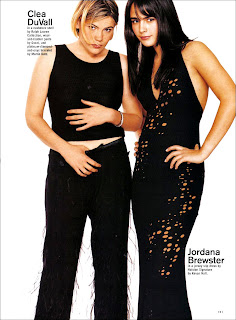
Claire Trevor and Dick Powell in a promotional portrait for Edward Dmytryk's film "Murder, My Sweet" (1944) based on Raymond Chandler's novel "Farewell, My Lovely" (1940)
Raymond Chandler would be the prime beneficiary of the noir renaissance of the 1970s, as two previously filmed Marlowe novels returned to the big screen. Chinatown’s success permitted director Dick Richards to mount a handsome period production of Farewell, My Lovely (1975) that even got to use Chandler’s original title. (The 1944 adaptation was called Murder, My Sweet so that audiences would not expect a musical, given that the star was song-and-dance man Dick Powell beginning his transition into harder-edged roles).

Richards’ Marlowe was Robert Mitchum, who had already delivered a piercing, valedictory performance as the low-level Boston hood working both sides of the law in 1973’s The Friends of Eddie Coyle. Once again, Marlowe is asked by newly-sprung pug Moose Malloy (ex-boxer Jack O’Halloran, taking the role played by Mike Mazurki in the first film) to find his “cute as lace pants” girlfriend Velma. Aside from changing “psychic consultant” Jules Amthor into a madam, screenwriter David Zelag Goodman largely sticks to Chandler’s novel. This fidelity isn’t a bonus as it saddles the film with Chandler’s plot, as easy to track as mercury on a tabletop. The production design smartly conveys the 1940s setting while the script overemphasizes it, with Marlowe offering commentary on Joe DiMaggio’s ongoing hitting streak and a newsie asking him at one point, “Whaddaya think of this guy Hitler?” Farewell offers its share of incidental pleasures.

Charlotte Rampling was born to play an icy femme fatale, and novelist Jim Thompson amusingly cameos as her power broker husband. In the film’s best scene, Mitchum duets with Sylvia Miles’ dipsomaniacal faded actress Jessie Florian and she bursts into tears over her lost youth. (Miles received an Oscar nomination largely for this scene alone). As good-looking and sincere as Farewell is, it leaves no lasting impression.

Robert Mitchum on the set of the movie 'Farewell, My Lovely', 1974.
It is infinitely better than Mitchum’s second turn as Marlowe. 1978’s The Big Sleep is set in then present-day England. The locale is addressed with a throwaway line about Marlowe coming to the U.K. during World War II and never going back. The time period seems to have been purely a financial decision, meant to save money on wardrobe and cars. In The Long Goodbye, Robert Altman restlessly probes the Marlowe-as-man-out-of-time conceit. Here, writer/director Michael Winner doubles down on the issue by moving the detective across the pond and never addresses the complications.

Mitchum was several decades too old for the role the first go-round. He played tired in Farewell. In Sleep he actually is tired. Understandably so, given how much of the film’s running time consists of shots of the actor striding across empty rooms. Marlowe is hired by fellow ex-pat General Sternwood to bail his hellion daughters out of trouble. The Sternwood clan is played by James Stewart, Candy Clark and Sarah Miles.

In 1950, Fleischer was continuing his upward trajectory with his fourth RKO noir, 'Armored Car Robbery.'

The film stars Charles McGraw, a man whom William Friedkin calls “the quintessential B picture film noir actor.” Friedkin sums up McGraw’s on-screen persona when he describes him as “the most hard boiled of the tough guys.” McGraw, who was a contract player for RKO and appeared in many “B” noirs during the late 1940s and early 1950s, had a face cut from granite, the leftover pieces of which were dumped down his throat and left to chafe against his vocal cords.

He was the perfect fit for the type of character he played in Armored Car Robbery: a hard-nosed cop out for blood after a gang of thugs botches—you guessed it—an armored car robbery, offing his partner in the process. The film boasts great performances, excellent nighttime cinematography, a stripped-down, fastmoving plot, and a fantastic final scene that preceded a similar ending in Stanley Kubrick’s noir classic The Killing (1956). But it wasn’t Armored Car Robbery that was destined to put Fleischer on the map. He reteamed with McGraw in 1950, and once he completed directing The Narrow Margin in just thirteen days, he knew he had something special.

The Narrow Margin (1952) publicity still of Peter Virgo, Jacqueline White, & Charles McGraw

As he put it, “everyone who saw it at the studio was convinced it was my breakthrough film.” And it would be. But not in 1950, and not in 1951. As Fleischer put it, in 1950, the film “came to the attention of Howard Hughes, who promptly put it in his projection booth, where it sat for more than a year.” His improbable run of autonomy had finally come to an end. He’d run up against the one-man wrecking crew who was unintentionally, but systematically, destroying RKO.
Check out lots of riveting articles you can find in the NOIR CITY magazine - Contribute to
Film Noir Foundation ordering the Spring issue of NOIR CITY online.
.jpg)







.jpg)


































